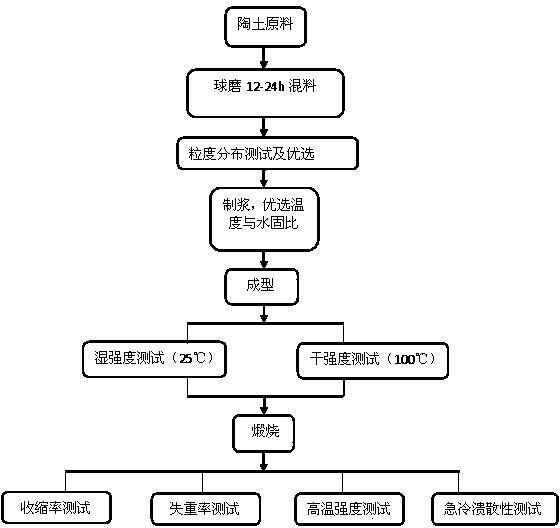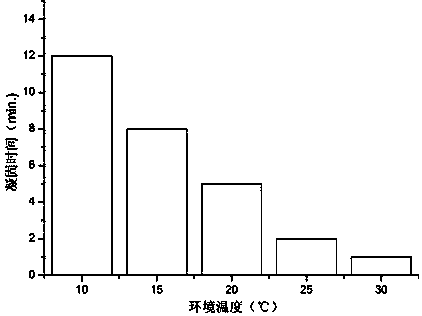Chlorine oxygen magnesium silicon clay material for inner layers of molds, preparation technology and evaluation method thereof
A magnesium oxychloride silicon pottery and soil material technology, which is applied to the inner layer material of the sintered cermet product forming mold and the field of powder metallurgy, can solve the problems of drill bit damage, difficulty in demoulding, cracking of the inner layer of clay, etc., and achieves fast molding speed, Good high temperature strength and rapid cooling collapse, easy to operate
- Summary
- Abstract
- Description
- Claims
- Application Information
AI Technical Summary
Problems solved by technology
Method used
Image
Examples
Embodiment 1
[0046]A magnesium oxychloride silica clay material for the inner layer of a mold, which is composed of the following components according to their weight percentages: magnesia 23%, silicon dioxide 45%, ammonium dihydrogen phosphate 20%, ammonium chloride 10%, silane coupling Agent 2%. That
[0047] Prepare as follows:
[0048] (1) Weigh each constituent material with an electronic balance, and carry out crushing, grinding, and screening;
[0049] (2) Calcination treatment: place magnesium oxide in a muffle furnace and calcinate at 1200°C for 2 hours;
[0050] (3) Ball mill the calcined magnesium oxide, silicon dioxide, ammonium dihydrogen phosphate, ammonium chloride and silane coupling agent for 20 hours;
[0051] (4) After mixing evenly, sieve, the particle size (μm) of the sieved powder is distributed according to volume percentage as follows:
[0052]
[0053] (5) Encapsulate and pack for use.
Embodiment 2
[0055] A magnesium oxychloride silica clay material for the inner layer of a mold, which is composed of the following components according to their weight percentages: magnesia 20%, silicon dioxide 40%, ammonium dihydrogen phosphate 25%, ammonium chloride 12%, silane Joint agent 3%.
[0056] It is prepared as follows:
[0057] (1) Weigh each constituent material with an electronic balance, and carry out crushing, grinding, and screening;
[0058] (2) Calcination treatment: place magnesium oxide in a muffle furnace and calcinate at 1200°C for 2 hours;
[0059] (3) Ball mill the calcined magnesium oxide, silicon dioxide, ammonium dihydrogen phosphate, ammonium chloride and silane coupling agent for 18 hours;
[0060] (4) After mixing evenly, sieve, the particle size (μm) of the sieved powder is distributed according to volume percentage as follows:
[0061]
[0062] (5) Encapsulate and pack for use.
Embodiment 3
[0064] A magnesium oxychloride silica clay material for the inner layer of a mold, which is composed of the following components according to their weight percentages: magnesia 18%, silicon dioxide 38%, ammonium dihydrogen phosphate 25%, ammonium chloride 14%, silane Joint agent 5%. It is prepared as follows:
[0065] (1) Weigh each constituent material with an electronic balance, and carry out crushing, grinding, and screening;
[0066] (2) Calcination treatment: place magnesium oxide in a muffle furnace and calcinate at 1200°C for 2 hours;
[0067] (3) Ball mill the calcined magnesium oxide, silicon dioxide, ammonium dihydrogen phosphate, ammonium chloride and silane coupling agent for 12 hours;
[0068] (4) After mixing evenly, sieve, the particle size (μm) of the sieved powder is distributed according to volume percentage as follows:
[0069]
[0070]
[0071] (5) Encapsulate and pack for use.
[0072] 2. The evaluation method of magnesium oxychloride silica clay...
PUM
 Login to View More
Login to View More Abstract
Description
Claims
Application Information
 Login to View More
Login to View More - R&D
- Intellectual Property
- Life Sciences
- Materials
- Tech Scout
- Unparalleled Data Quality
- Higher Quality Content
- 60% Fewer Hallucinations
Browse by: Latest US Patents, China's latest patents, Technical Efficacy Thesaurus, Application Domain, Technology Topic, Popular Technical Reports.
© 2025 PatSnap. All rights reserved.Legal|Privacy policy|Modern Slavery Act Transparency Statement|Sitemap|About US| Contact US: help@patsnap.com



